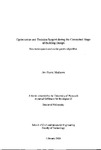Optimisation and Decision Support during the Conceptual Stage of Building Design
| dc.contributor.author | Mathews, Jim David | |
| dc.contributor.other | School of Engineering, Computing and Mathematics | en_US |
| dc.date.accessioned | 2013-10-29T12:55:35Z | |
| dc.date.available | 2013-10-29T12:55:35Z | |
| dc.date.issued | 2000 | |
| dc.identifier | NOT AVAILABLE | en_US |
| dc.identifier.uri | http://hdl.handle.net/10026.1/2449 | |
| dc.description | Merged with duplicate record 10026.1/726 on 28.02.2017 by CS (TIS) | |
| dc.description.abstract |
Modern building design is complex and involves many different disciplines operating in a fragmented manner. Appropriate computer-based decision support (DS) tools are sought that can raise the level of integration of different activities at the conceptual stage, in order to help create better designs solutions. This project investigates opportunities that exist for using techniques based upon the Genetic Algorithm (GA) to support critical activities of conceptual building design (CBD). Collective independent studies have shown that the GA is a powerful optimisation and exploratory search technique with widespread application. The GA is essentially very simple yet it offers robustness and domain independence. The GA efficiently searches a domain to exploit highly suitable information. It maintains multiple solutions to problems simultaneously and is well suited to non-linear problems and those of a discontinuous nature found in engineering design. The literature search first examines traditional approaches to supporting conceptual design. Existing GA techniques and applications are discussed which include pioneering studies in the field of detailed structural design. Broader GA studies are also reported which have demonstrated possibilities for investigating geometrical, topological and member size variation. The tasks and goals of conceptual design are studied. A rationale is introduced, aimed at enabling the GA to be applied in a manner that provides the most effective support to the designer. Numerical experiments with floor planning are presented. These studies provide a basic foundation for a subsequent design support system (DSS) capable of generating structural design concepts. A hierarchical Structured GA (SGA) created by Dasgupta et al [1] is investigated to support the generation of diverse structural design concepts. The SGA supports variation in the size, shape and structural configuration of a building and in the choice of structural frame type and floor system. The benefits and limitations of the SGA approach are discussed. The creation of a prototype DSS system, abritrarily called Designer-Pro (DPRO), is described. A detailed building design model is introduced which is required for design development and appraisal. Simplifications, design rationale and generic component modelling are mentioned. A cost-based single criteria optimisation problem (SCOP) is created in which other constraints are represented as design parameters. The thesis describes the importance of the object-oriented programming (OOP) paradigm for creating a versatile design model and the need for complementary graphical user interface (GUI) tools to provide human-computer interaction (HCI) capabilities for control and intelligent design manipulation. Techniques that increase flexibility in the generation and appraisal of concept are presented. Tools presented include a convergence plot of design solutions that supports cursor-interrogation to reveal the details of individual concepts. The graph permits study of design progression, or evolution of optimum design solutions. A visualisation tool is also presented. The DPRO system supports multiple operating modes, including single-design appraisal and enumerative search (ES). Case study examples are provided which demonstrate the applicability of the DPRO system to a range of different design scenarios. The DPRO system performs well in all tests. A parametric study demonstrates the potential of the system for DS. Limitations of the current approach and opportunities to broaden the study form part of the scope for further work. Some suggestions for further study are made, based upon newly-emerging techniques. | en_US |
| dc.language.iso | en | en_US |
| dc.publisher | University of Plymouth | en_US |
| dc.title | Optimisation and Decision Support during the Conceptual Stage of Building Design | en_US |
| dc.type | Thesis | |
| plymouth.version | Full version | en_US |
| dc.identifier.doi | http://dx.doi.org/10.24382/4446 |
Files in this item
This item appears in the following Collection(s)
-
01 Research Theses Main Collection
Research Theses Main


